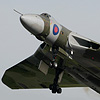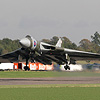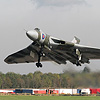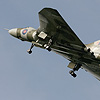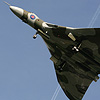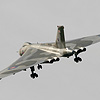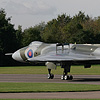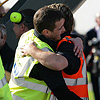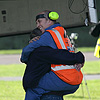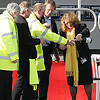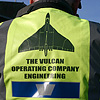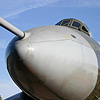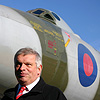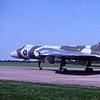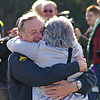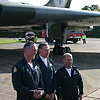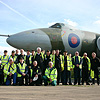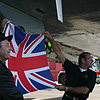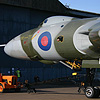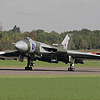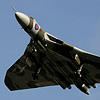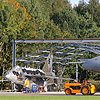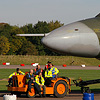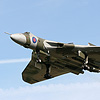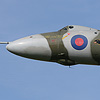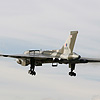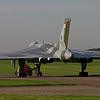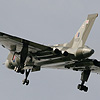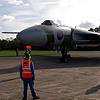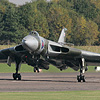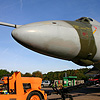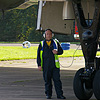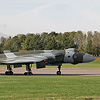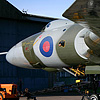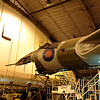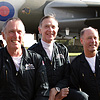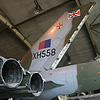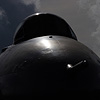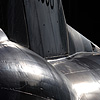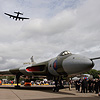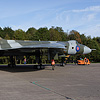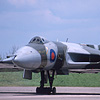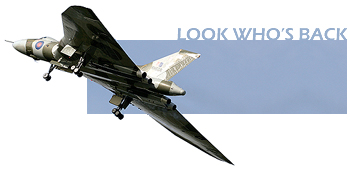
Vulcan XH558 First Flight Feature Report
Thursday 18th October
The Avro Vulcan is the very essence of what got me hooked on aviation in the first place. Seeing XH558 at shows at Cosford back in the 1980s is something which has never left me. Now, too many years later, standing at Bruntingthorpe, there may have been a few more wrinkles and the first couple of tell-tale grey hairs, but inside I was eight years old again. "Awesome" is a word which is overused and has become a cliche in modern mediaspeak, but to see the giant Tin Triangle roar down the runway and unstick from terra firma for the first time in nearly a decade and a half, was an occasion where that word was completely appropriate, and yet felt almost too insignificant to faithfully express what had just happened.
reports for UKAR, with additional photography from , and .
I don't mind admitting I didn't sleep much the night before, and set no fewer than three alarm clocks to ensure I'd not miss something we've all waited so long for. The British airshow circuit has become a little "samey" in recent years, with the retirement of several much-loved types, the operational demands on others, and the RAF's recent decision to support fewer shows and to move away from individual displays in favour of the "Role Demo". The display circuit needs a star, and on a chilly autumnal day in 2007, that star returned to the heavens.
Even the weather had a sense of occasion. Dawn broke over the Leicestershire countryside with a gorgeous pink half-light and wispy fog clinging to the fields around Bruntingthorpe. It was bitterly cold for us early-risers, but I'm sure I wasn't alone in thinking I'd not have traded being there for anything else in the whole world.
Rumours spread of a snag - possibly with XH558's braking parachute, and certainly there was a delay, with the 9am roll-out time coming and going. Unlike many events with a large media presence, there wasn't a cross word from anyone, no tutting or moaning, the mood was optimistic, we knew we just had to wait, and everything would be okay. We'd waited 14 years, what difference would another few minutes make?
Eventually the giant hangar doors slid open and the Vulcan was reversed out, basking in the bright sunshine and looking just fabulous beneath ice-blue skies. I'd not seen this aircraft since her previous display career, and had forgotten what a sensational "looker" she is. Her paint might need a cosmetic spruce-up here and there, but there's no denying she still strikes a mean pose.
At this point it's probably worth giving a brief potted history of XH558. She was the first B.2 variant to enter RAF service, and was the last to retire, having been kept on as an airshow performer and recruitment tool long after the rest of the Vulcan fleet had been retired in 1984, two years after they'd tasted combat in the famous Black Buck raids on the Falkland Islands. '558 didn't play a part in that conflict and ended her standard service days modified to a K.2 tanker configuration. Succeeding XL426 (currently preserved in taxying condition at Southend Airport) with the Vulcan Display Flight she became a legend on the airshow circuit, until cuts in the Defence budget meant that the RAF could no longer afford to keep and maintain her, and in 1993 as the last flying Vulcan she was retired to Bruntingthorpe, amid much genuine sadness. And until this year no Vulcan had flown since that day. You can see pictures from '558's "past life" and restoration towards the bottom of this article.
So, as the clock ticked towards the scheduled start time of 11:30am, and after the first of many rounds of TV, radio and press interviews with those behind the project, the aircraft was towed to an apron adjacent to Bruntingthorpe's runway for pre-flight checks and start-up.
The whistling whine of the idling Olympus engines broke through the still, crisp air, and their note changed as the aircraft began to taxi towards the runway.
And then, a touch later than planned, at 12:27pm on Thursday, October 18th, 2007 The Vulcan Operating Company achieved what many had thought beyond them. With a raucous howl of four Olympus engines, Avro Vulcan B.2 XH558 began to pick up speed along the runway. "She's up!" cried someone nearby, and so she was. Having used barely any runway at all, this leaner incarnation of '558 was climbing majestically, noisily and gloriously into the clear blue skies. What a sight! What a sound! This hobby of ours simply doesn't get any better than this. A real "I was there" moment, and suddenly I'd stopped being an occasionally grumpy, often cynical 29-year-old, and was a boy of eight again watching in awe and wonder as I had done at Cosford, Coventry or Fairford all those years ago.
She kept her gear extended for the first few minutes and disappeared for 30 minutes or so, as the crew went through elementary checks of the aircraft's handling, returning for a low pass along the runway before entering the circuit to land. The landing, for the record was just about the smoothest I can recall from any aircraft, her rear wheels barely kissing the asphalt with the merest hint of a puff of tyre smoke, pilot Al McDicken keeping her nose high to bleed off speed, with no need for the 'chute.
And that was that. "Did that actually happen?" I asked a friend. But it had, after 14 years of landlubbing, XH558 had flown. And it was like she'd never been away.
After she'd taxyed to her parking space before a cheering crowd, there were scenes of jubilation from the engineering staff who have worked so hard to get the job done. This was as much their triumph as that of the the aircraft, the aircrew or the management of TVOC. Champagne bottles were uncorked and it began to sink in that the dream had been realised.
The hungry press pack rushed in and quickly grabbed interviews with everyone from the pilots McDicken and Dave Thomas to the Chief Executive of the Vulcan To The Sky Trust, Dr Robert Pleming to David Walton, the man who bought the machine, and brought it to Bruntingthorpe way back in 1993.
What were their thoughts? Well McDicken was clearly delighted and could barely disguise his broad grin: "She was an absolute delight, every bit as good as I can remember. It was a tremendous privilege to fly it again. We were suitably aroused! There were no problems during the flight, none at all, and that's a tremendous tribute to the [TVOC] team as well as the designers who produced this aeroplane so many years ago".
McDicken's co-pilot Dave Thomas revealed what they'd managed to accomplish in their 30 minutes or so in the air, flying out to a radius of 35 miles from Bruntingthorpe: "It was a very basic flight today. Simple things like handling tests going from threshold speeds up to around 250 knots. If anything, she actually handles better than before, because of all the work that's been done to her."
If there's one question mark still hanging over the future of XH558, it's the question of funding. A major sponsor is needed as a matter of course, if not urgency, and as of the date of her first flight, none has been forthcoming. Dr Pleming is hopeful that now the aircraft is a "flyer", attracting investors will be an easier proposition: "We need to change gear, from getting the revenue to return to flight to finding the funds to keep her flying. The turnout here today [from the media] should help because it shows that this aircraft does generate attention, so for any potential sponsor, now we've got the proof!"
As an aside, donation cheques totalling £6,000 were collected on the day.
Dr Pleming has recently been named "Preservationist Of The Year", and for all the criticism he and The Vulcan Operating Company have taken, Pleming and his team would do well to just step back from the celebrating and take a moment to consider the enormity of what they have achieved: XH558 is by some distance the most complex restoration-to-flight ever undertaken anywhere in the world; never before has so much red-tape and bureaucracy been been both tackled and overcome, and never before has an aircraft restoration grabbed the attention of the wider world quite in the way this one has. The continued safe operation of this machine opens up all kinds of possibilities for the restoration of complex vintage types. Pats on the back yes, but still much hard work lies ahead. The 2008 airshow season can't come quickly enough!

